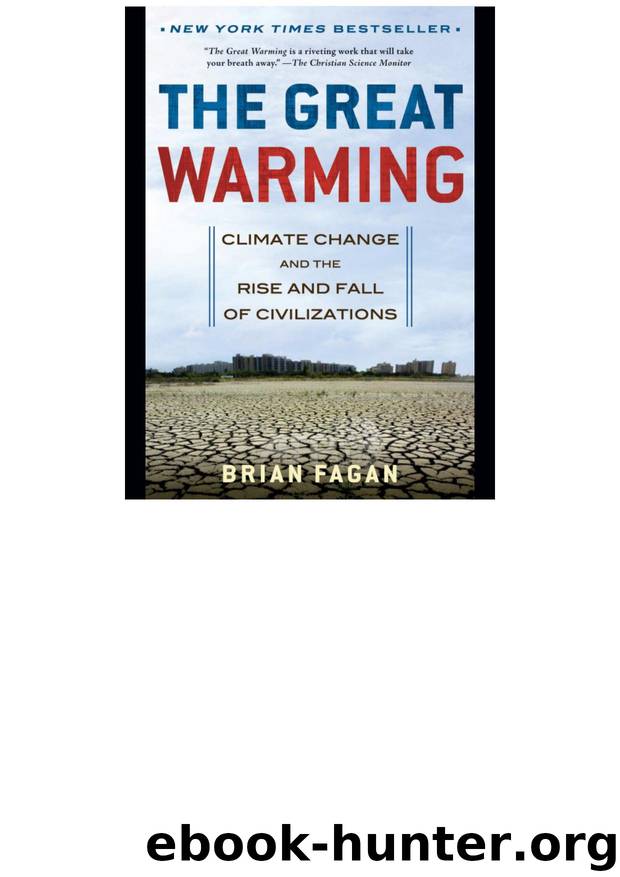The Great Warming by Brian Fagan

Author:Brian Fagan [Fagan, Brian]
Language: eng
Format: epub
Tags: book, ebook
ISBN: 9781596917804
Publisher: Bloomsbury Publishing Plc
Published: 2010-07-24T04:00:00+00:00
A HOT, SULTRY afternoon has settled on the floor of Chaco Canyon, New Mexico. The air is heavy and still, weighing on the visitors passing through the empty rooms of Pueblo Bonito. A huge bank of black thunderclouds masses on the western horizon, mocking the bright sunlight shining on the canyon walls. The clouds pile ever higher. Distant lightning flickers through the menacing overcast; thunder rumbles ominously. Violent wind gusts sweep through the canyon; a few heavy raindrops spatter the sandy path. The visitors run for shelter under a nearby overhang. A wall of gray approaches, but evaporates as the approaching storm changes course and drops its load downstream. Bright sunlight returns to bake the canyon floor once again.
If you live in a semiarid environment, you have to be prepared to roll with the climatic punches. The Ancestral Pueblo of the Southwest were masters of flexible and opportunistic living in landscapes where movement meant survival. A modern-day Tewa Indian oral tradition from the Southwest proclaims: “Movement, clouds, wind and rain are one. Movement must be emulated by the people.”15 Great Basin bands survived through mobility. Coastal fishing groups moved into more densely populated villages. All of these people were hunters and wild plant gatherers, but others cultivated maize and beans and lived by farming the land. Farming was not a viable option in desert areas; California Indians with their acorn harvests had no incentive to grow crops. But, in the Southwest, conservative farmers, who were experts at water management, thrived in often agriculturally marginal environments for over three thousand years.
Chaco Canyon lies in the heart of the San Juan basin, a seemingly empty landscape that appears to stretch forever.16 Water in any form is short in the basin; summer rainfall arrives as thunderstorms, gentler, if sporadic, winter rains in the form of snow between December and March. But the amount of rainfall is very small, invariably localized, and utterly unpredictable. Short-term climatic shifts such as El Niños or prolonged droughts like those of the Medieval Warm Period could have a profound effect on agriculture on a year-by-year basis. Chaco Canyon is about 18.6 miles (30 kilometers) long and between a third and nearly a mile wide (0.5 and 1.5 kilometers). After storms, the Chaco Wash flows strongly through the canyon, which is also watered by side streams and by natural seeps at the foot of the surrounding cliffs. But in times of drought the canyon floor is bone dry.
Hardly a promising location for any form of agriculture, one would think, but between the ninth and twelfth centuries, at least 2,200 people dwelled within the canyon, and its population swelled considerably at times of major ceremonies. Numerous small hamlets of a few stone houses thrived at Chaco, also nine large pueblos, commonly known as great houses. The permanent residents of Chaco farmed fertile patches of soil with the simplest of digging sticks and hoes. How many of them lived in the great houses rather than in hamlets we don’t know, but
Download
This site does not store any files on its server. We only index and link to content provided by other sites. Please contact the content providers to delete copyright contents if any and email us, we'll remove relevant links or contents immediately.
Man-made Catastrophes and Risk Information Concealment by Dmitry Chernov & Didier Sornette(4750)
The Revenge of Geography: What the Map Tells Us About Coming Conflicts and the Battle Against Fate by Kaplan Robert D(3602)
Zero Waste Home by Bea Johnson(3297)
COSMOS by Carl Sagan(2961)
In a Sunburned Country by Bill Bryson(2954)
Good by S. Walden(2921)
The Fate of Rome: Climate, Disease, and the End of an Empire (The Princeton History of the Ancient World) by Kyle Harper(2444)
Camino Island by John Grisham(2392)
A Wilder Time by William E. Glassley(2367)
Organic Mushroom Farming and Mycoremediation by Tradd Cotter(2314)
Human Dynamics Research in Smart and Connected Communities by Shih-Lung Shaw & Daniel Sui(2181)
The Ogre by Doug Scott(2121)
Energy Myths and Realities by Vaclav Smil(2069)
The Traveler's Gift by Andy Andrews(2017)
Inside the Middle East by Avi Melamed(1946)
Birds of New Guinea by Pratt Thane K.; Beehler Bruce M.; Anderton John C(1915)
Ultimate Navigation Manual by Lyle Brotherton(1770)
A History of Warfare by John Keegan(1723)
And the Band Played On by Randy Shilts(1622)
